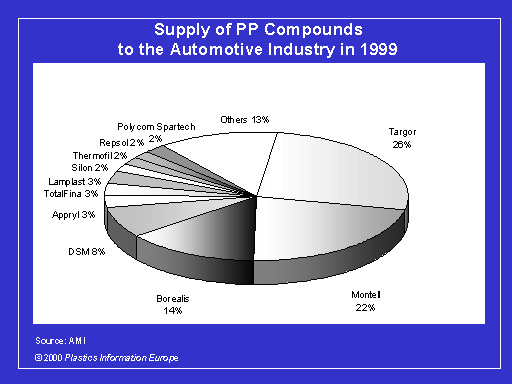POLYPROPYLENE
PP compounds: A one million tonne market in Europe / Automobile sector the largest market
In 1999 polypropylene compound consumption exceeded one million tonnes in Europe for the first time. The industry has been enjoying growth rates of 6% per year, but growth rates are forecast to slow over the next five years according to a new in-depth study on the market from AMI Consulting (GB-Bristol).
The recent round of mergers in the polyolefins business will have major implications for PP compound supply structure. The creation of Basell through the merger of Targor and Montell creates a clear market leader with an estimated 44% market share based on 1999 production volumes. Some 130,000 tonnes of PP compounding capacity though will have to be sold under EU competition rules to enable the merger to go ahead. This will further alter the supply structure depending on which sites are sold and where these assets end up. According to the report´s author, John Nash, “Borealis and DSM are likely to be the companies most affected but it also represents a significant opportunity for PP producers underrepresented in the compounding business and the large independent US compounders.”
According to AMI´s analysis Montell is considered to have a profitable compounding business and is one of the few integrated compounders where compounding usually adds real value. It has achieved this through focussing on demanding higher value applications. Targor, in contrast, is believed to make little money out of its compounding business because of its focus on lower price applications.
Profitability in the industry has also been influenced by shifts in the structure of demand. This is particularly the case in the automotive industry, which is the largest individual market for PP compounds accounting for over 50% of market volume. The OEMs are increasingly delegating responsibility to their Tier One suppliers, who are pressing for greater value for money. This shift of responsibilities means for several car companies/applications the compounders are now selling direct to Tier One suppliers who are fully empowered to select and approve suppliers. These companies are giving greater emphasis to price rather than performance improvements. A related threat to the PP compound market is the increasing penetration of reactor resins used in conjunction with masterbatch. Compounders have responded by putting less effort into performance enhancements and a less aggressive attitude to gaining new business.
The domestic appliance sector is the second largest market and growth here has been driven by increased penetration of PP compounds in washing machine drums. PP compound and application development though has been slower than in the automotive sector. Improved reactor resins have started to take market share from PP compounds especially in small appliances.
The fastest growing sector is in building where opportunities lie in pipe and sheet where PP compounds are finding niche applications enabling them to displace PVC, PE and traditional materials.
The recent round of mergers in the polyolefins business will have major implications for PP compound supply structure. The creation of Basell through the merger of Targor and Montell creates a clear market leader with an estimated 44% market share based on 1999 production volumes. Some 130,000 tonnes of PP compounding capacity though will have to be sold under EU competition rules to enable the merger to go ahead. This will further alter the supply structure depending on which sites are sold and where these assets end up. According to the report´s author, John Nash, “Borealis and DSM are likely to be the companies most affected but it also represents a significant opportunity for PP producers underrepresented in the compounding business and the large independent US compounders.”
According to AMI´s analysis Montell is considered to have a profitable compounding business and is one of the few integrated compounders where compounding usually adds real value. It has achieved this through focussing on demanding higher value applications. Targor, in contrast, is believed to make little money out of its compounding business because of its focus on lower price applications.
Profitability in the industry has also been influenced by shifts in the structure of demand. This is particularly the case in the automotive industry, which is the largest individual market for PP compounds accounting for over 50% of market volume. The OEMs are increasingly delegating responsibility to their Tier One suppliers, who are pressing for greater value for money. This shift of responsibilities means for several car companies/applications the compounders are now selling direct to Tier One suppliers who are fully empowered to select and approve suppliers. These companies are giving greater emphasis to price rather than performance improvements. A related threat to the PP compound market is the increasing penetration of reactor resins used in conjunction with masterbatch. Compounders have responded by putting less effort into performance enhancements and a less aggressive attitude to gaining new business.
The domestic appliance sector is the second largest market and growth here has been driven by increased penetration of PP compounds in washing machine drums. PP compound and application development though has been slower than in the automotive sector. Improved reactor resins have started to take market share from PP compounds especially in small appliances.
The fastest growing sector is in building where opportunities lie in pipe and sheet where PP compounds are finding niche applications enabling them to displace PVC, PE and traditional materials.
 | |
15.02.2001 Plasteurope.com [16892]
Published on 15.02.2001
